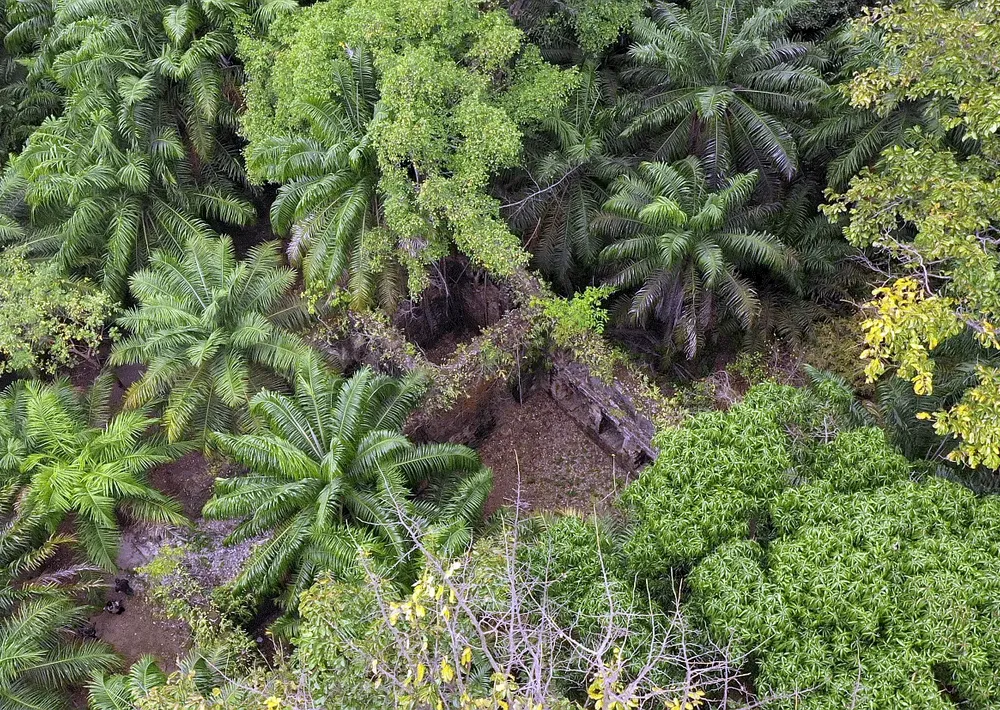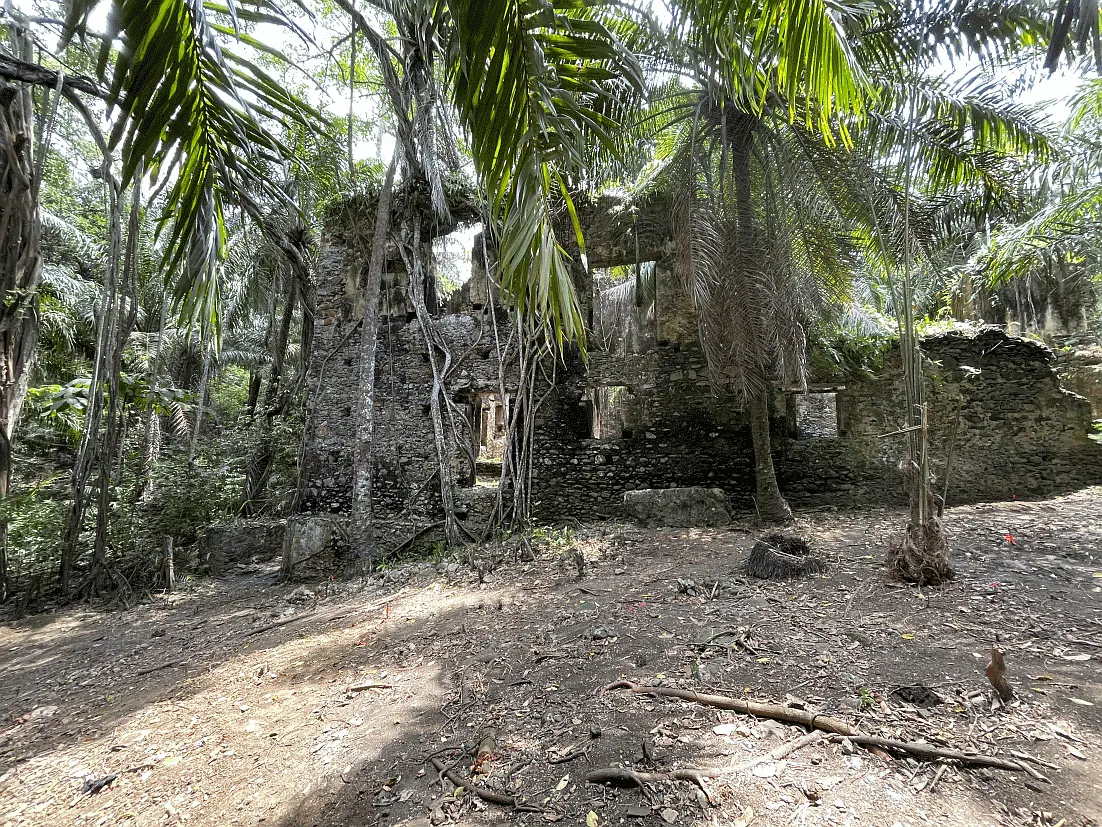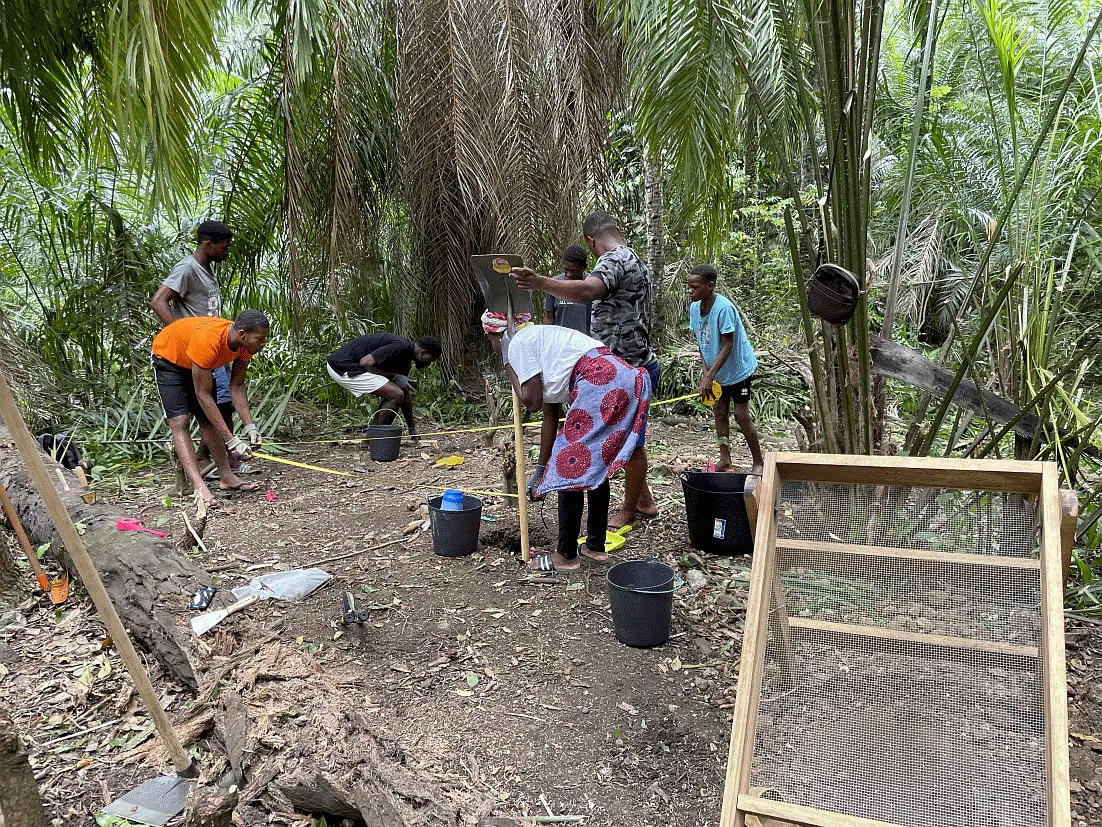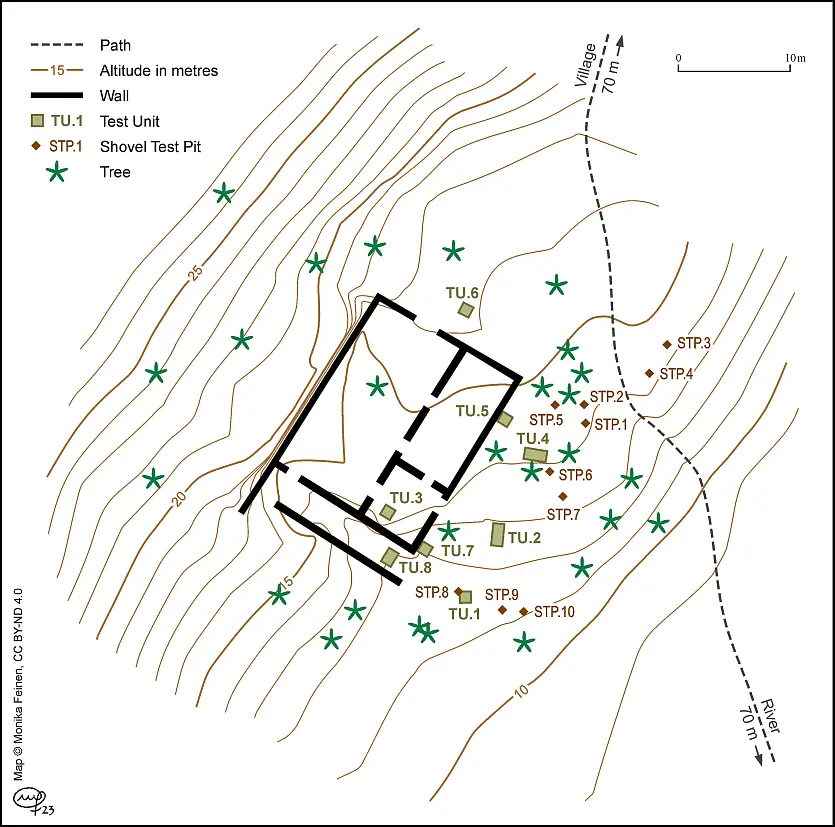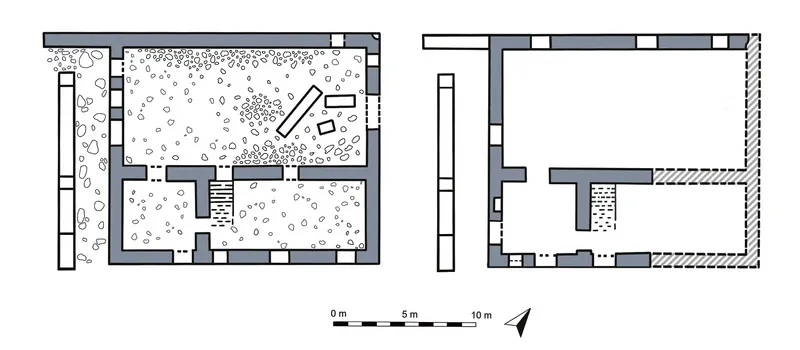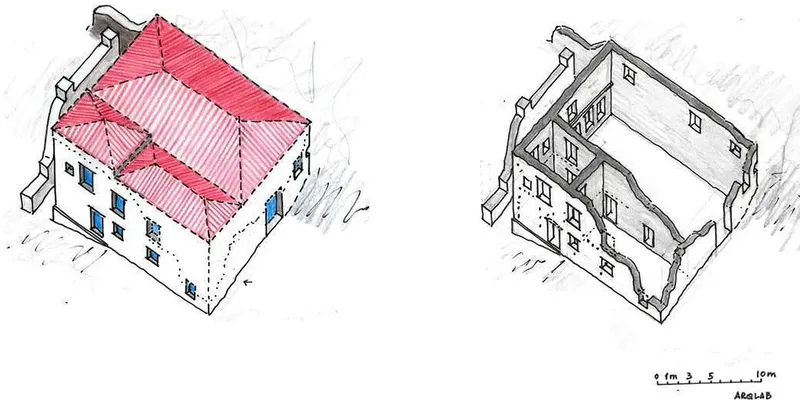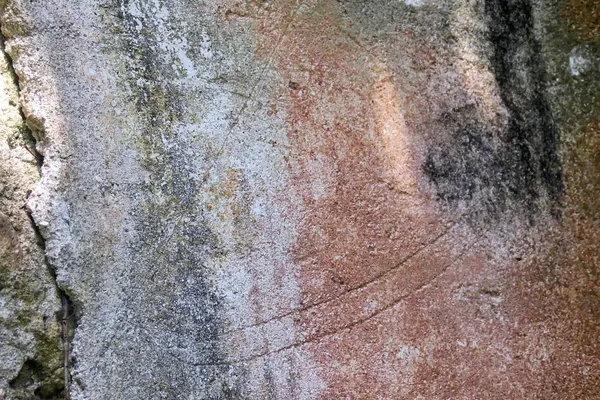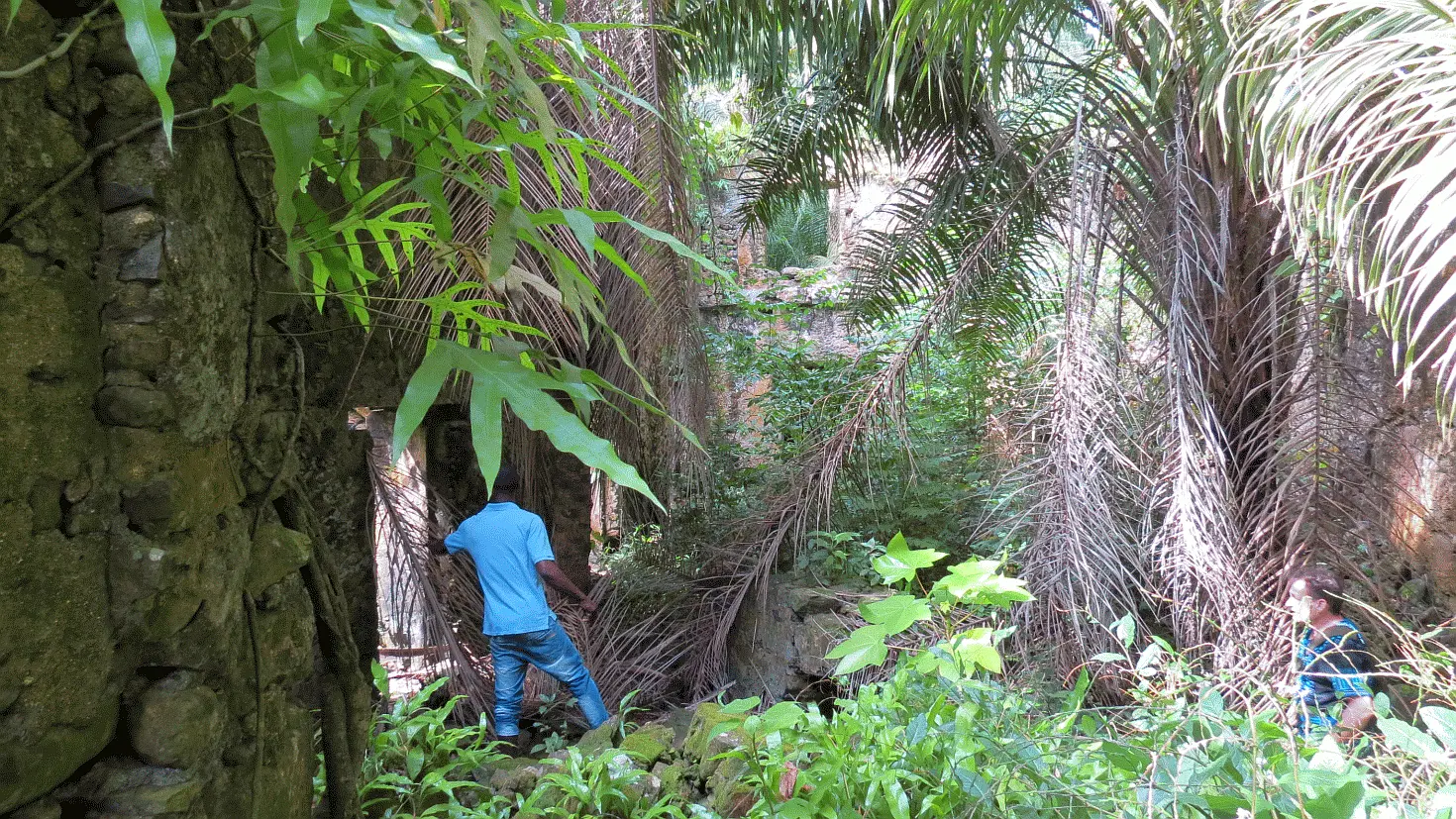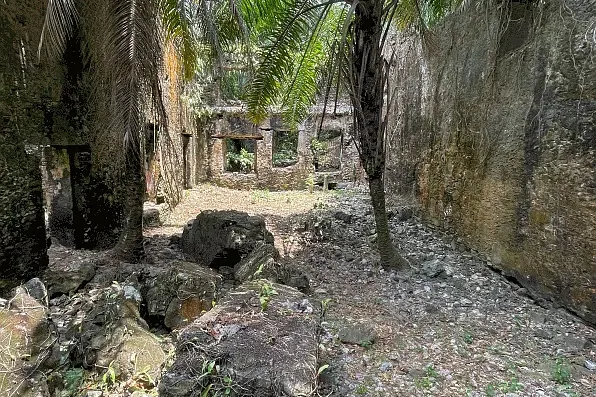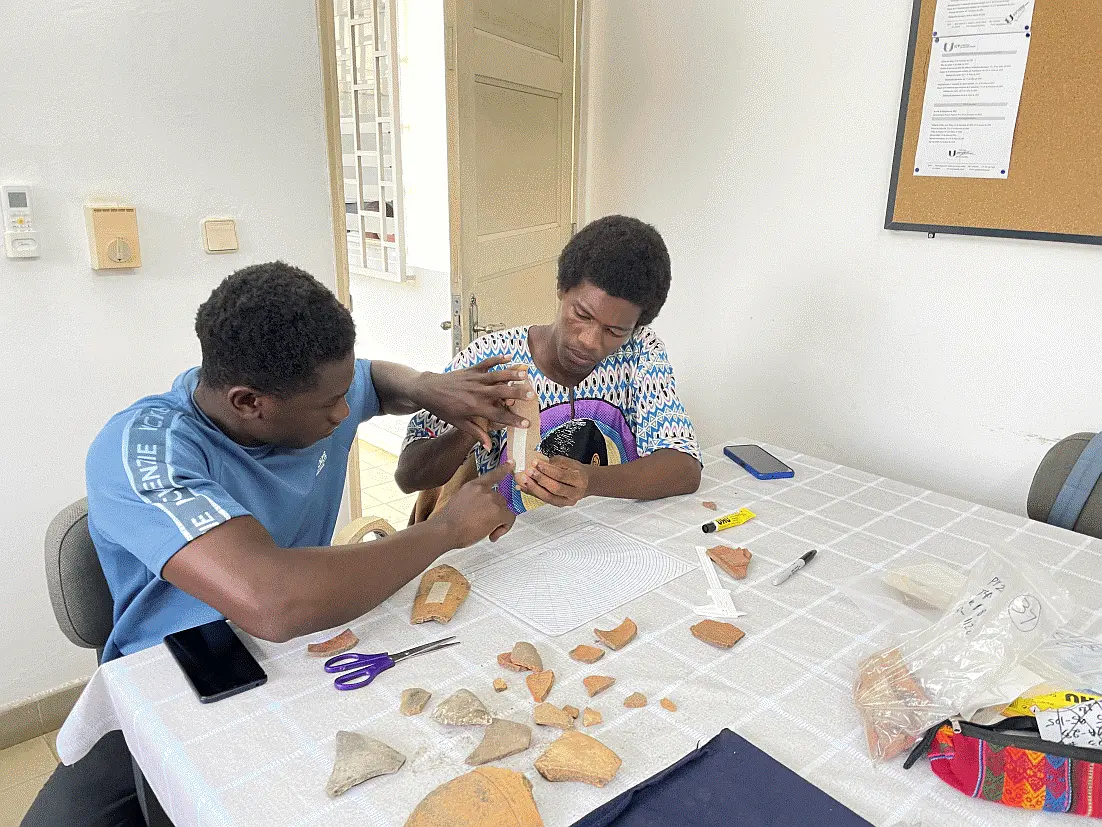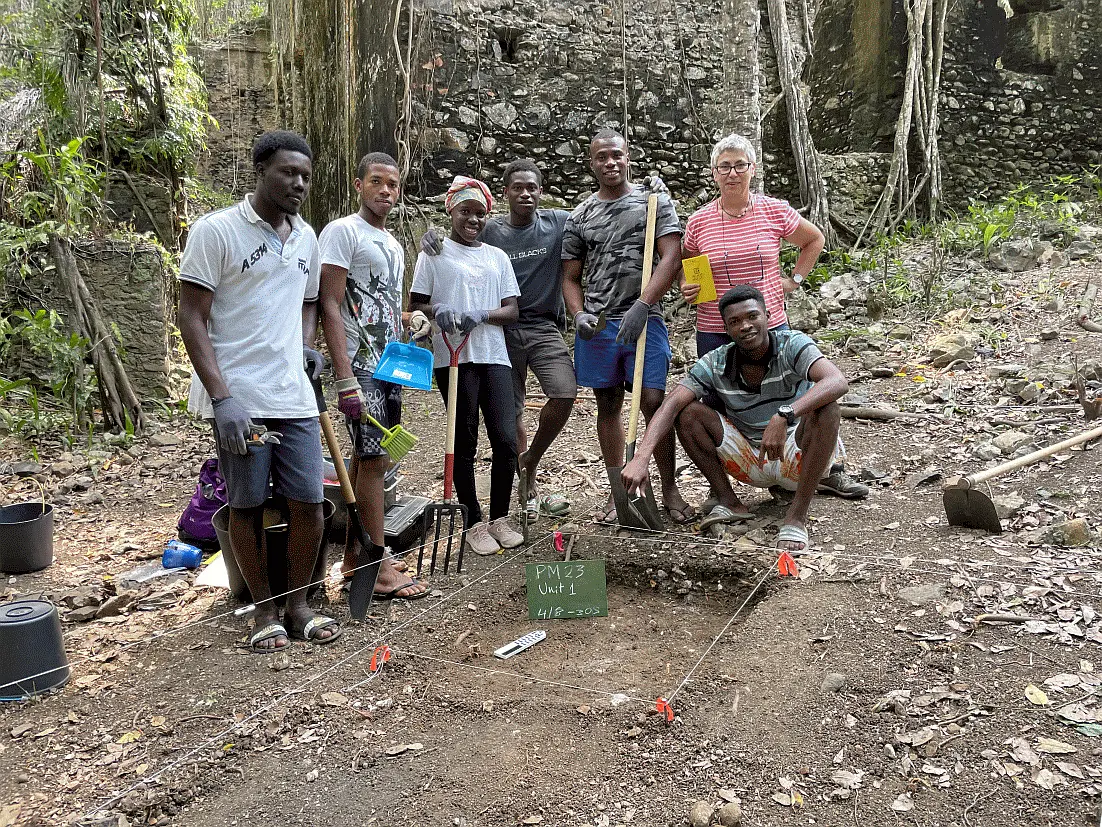Bitter Island: exploring Portuguese colonial landscapes in São Tomé’s sugar plantation cycle (16th-17th century)
Praia Melão (São Tomé) 16.07. – 25.08.2023
M. Dores Cruz (mdores.cruz@uni-koeln.de)
Beneath the shade of dense tropical forest canopy, university students and Project team members work at different tasks – some digging excavation units, some taking notes, some drawing stratigraphic profiles, and some manning shaker screens, agitating the soil to collect artifacts from the square units being dug in the area within and around the towering stone ruins. The site is Praia Melão, the remains of a sugar plantation whose ruinous water powered mill and estate house building stands as testament to the lives of enslaved workers brought to São Tomé some 500 years ago. One of the students steps away from the screen, hand extended: “Look.” In her palm was a brilliant white cowrie shell.
In the 16th century, a small island in the Gulf of Guinea became the site of a transformative innovation with devastating implications for generations of captive Africans and their descendants, the history of plantation capitalism, and the structural inequalities of the modern world. Colonial entrepreneurs from Portugal and elsewhere in Europe devised a means of producing sugar using the natural fertility and favorable climate of São Tomé paired with forced labor obtained from mainland Africans brought to the newly established plantations there. The plantation economic model predicated on the labor of enslaved Africans was invented in São Tomé and then exported throughout the colonial world.
Over the ensuing centuries, São Tomé became a nexus between Europe, Africa, and the Americas, playing a seminal role in the emergence of the capitalist plantation system, transnational networks of trade, labor models predicated on forced migration, and colonial empire building; in short, the modern Atlantic world. However, the absence of archaeological research and omission of São Tomé from high-profile historical discourse has meant that the island’s significance in world history remains largely unknown. Scholarship on São Tomé’s early history is meager, mainly published in Portuguese with limited international attention, and to date, none has focused on cultural landscapes and materiality—the physical record of the lives of those who toiled in São Tomé’s sugar plantations against their will 500 years ago.
The project at Praia Melão is the first archaeological research in São Tomé. An international collaborative effort that brings together scholars from a diversity of fields and origins – M. Dores Cruz (PI / Principal investigator, University of Cologne), Nazaré Ceita and Natália Umbelina (University of São Tomé e Príncipe), Larissa Thomas (Environmental Resources Management), Nadine Nolde (University of Cologne), and Álvaro Castilla Beltrán (University of La Laguna) – the aim is to bring the island to the attention of discussions on the emergence of the modern Atlantic world, plantation archaeology, and colonial identities. The work is adding to the comparative body of knowledge on plantation slavery through focus on perhaps the earliest known site of its kind. Research is revealing how aspects of the plantation system developed in this island and how observations from São Tomé fit within the broader picture of nascent colonialism in Africa. Archaeological research at Praia Melão is unearthing clues about a critical period that fundamentally changed global economic and cultural currents, spotlighting one small island’s place at the fulcrum of history. The engenho at Praia Melão was the largest sugar mill and estate in São Tomé, at times reported as having between 200 and 300 enslaved workers. It was established in the 16th century and remained in use until the 19th century, retooled after the mid-17th century for production of alcohol and casava flour.
The site has been the subject of archaeological survey and excavations in 2022 and 2023 that are beginning to expose the all but forgotten story of plantation slavery’s origins. Praia Melão records the day-to-day lives of enslaved Africans producing sugar for the European market, and the site’s history also presages themes of agency: local resistance, including armed revolts and establishment of maroon communities in the island’s rugged interior, and creolization, a dynamic process that produced a unique society and identity in São Tomé. Although Praia Melão is a site of international historical significance, it is poorly known, even in São Tomé, and largely unprotected. There is particular urgency in expanding research at Praia Melão, given that the site retains rare surviving ruins of 16th century architecture, which are in danger of collapse.
Findings and future research
The 2023 exploratory excavation exposed site deposits on the exterior and interior of the engenho, uncovering evidence of sugar production activities, how the facility was constructed, and later reuse of the site after the production of sugar decreased and was eventually abandoned. The excavations yielded a wide variety of artifacts, with a high percentage being roof tiles (105 kg found mainly in the two upper excavation levels, resulting from the decay and partial collapse of the building) and fragments of sugar molds, which are witnesses to the production taking place at the site. In addition to Portuguese domestic ceramics, the findings included a small number of artifacts possibly with African origins, which included the cowrie shell, fragments of ceramics that resemble continental ceramics, and a fragment of a finely decorated pipe stem. The objects brought to the site from the mainland or made in styles adhering to continental traditions are of particular interest as a window into the persistence of culture among people displaced at the dawn of the African diaspora.
Analysis of artifacts, faunal remains, and soil is underway and it has the possibility to reveal aspects of daily life – namely dietary characteristics – of those working at Praia Melão, as well as environmental changes resulting from human impacts on what had been an uninhabited island until the arrival of the Portuguese in the early 1470s. Colonization entailed the introduction of new species and intensive monoculture production, which left an indelible imprint on the landscape, and which will be represented in pollen and phytoliths preserved in the deep stratigraphy of Praia Melão.
Future excavations at Praia Melão will expand our understanding of daily life and the material conditions within the sugar socio-economic complex. Importantly, the project incorporates practical archaeology training for Santomean university students and heritage staff, and engages in collaborative research, local community engagement and participation, contributing to a decolonized archaeological practice. A central aim of this research is to restore São Tomé to its proper place of prominence in the historical narrative, putting Africa and Africans at the core of the origins of modernity.

The future of archaeology in São Tomé and of the site
During the summer of 2023, the archaeology field school included four University of São Tomé e Príncipe students and three members of the local community. Two of the students and the local community liaison continued their training in February – March 2024, with a first-year university student also joining the team participating in artifact analysis for the Praia Melão assemblage. Furthermore, the PI collected oral history that brought to light a localized tradition of ceramic production in a village on the west side of the island, the only instance of local ceramic making in the modern era that has been documented. Following up on this discovery, the PI and students initiated ethnoarchaeological research in the village, the findings of which may provide insights into continuity and change in ceramic production from the time Praia Melão was established to the present.
As part of our efforts to publicize the early history of São Tomé within the country as well as internationally, we produced a variety of publicly oriented information materials:
- a pamphlet (in Portuguese) to distribute locally, particularly among neighboring communities and local politicians
- a short video available on YouTube and which includes subtitles in English and in German (see media )
- an article published in SAPIENS (see References )
- and finally, the project has been featured in a number of international media platforms
Our goal is to inform Santomeans about a less known period of their history, while working to protect the Praia Melão site. As a crucial part of that effort, the PI and two Santomean partners (Prof. Nazaré Ceita and Prof. Natália Umbelina) have pursued getting the site listed as a monument of national interest.
Meetings with the Minister of Culture in 2023 and with the Prime Minister in early 2024 have borne fruit, and Praia Melão was officially designated as a national historic monument in late 2024. Securing the site’s preservation will open international funding opportunities and may contribute, in the long term, to sustainable tourism projects that would support economic development in the neighboring community.
Conclusion
After the decline of sugar production in the 17th century, the mill and estate house in Praia Melão survived for c. 400 years thanks to changes in production strategies. Its preservation also may owe to the fact that the population who lives nearby is intimidated by stories of ghosts; even children avoid entering the site. Despite being located along a well-trafficked footpath, the neighboring community is unaware of the site’s historical and cultural significance. But encroaching vegetation, economic development, increasing tourism, and other potential human impacts heighten the site’s risk of destruction, making protection efforts and further archaeological investigations urgent, and necessitating the involvement of the local and national government, and training of local specialists. Thus, our aim is to work closely with local officials, and continue to engage and empower local communities in an effort to preserve the integrity of the site.
Despite bureaucratic impediments, concerns by some neighbors that the site is haunted, and the usual stories that we were digging to find the pot of gold left behind by some unnamed grandmother, the project is slowly achieving results at the local level. In a trip to the hospital to X-ray a ceramic vessel excavated from the engenho, the PI struck up a conversation with a bakery owner from the town of Trindade, in the same district where Praia Melão is located. Sr. Fonseca was intrigued by the work we were conducting and was shocked by the fact that such an imposing and important building was not known by the people in the district and was not mentioned in school. According to him and to Apssy, the project field assistant, the sugar complex and slavery are rarely mentioned in high-school and even local tourist guides don’t know about it. Sr. Fonseca was very keen to know more about the site and suggested that his daughter should join the next field season to learn about São Tomé’s earlier history. Likewise, when people from villages farther away tried to steal stones from the building’s walls to sell as construction material, Edsiley, our community liaison, quickly assembled some neighbors to chase the thieves away and prevent the site’s destruction. According to him, the building is now considered more than just a place of ghosts. Neighbors are proud of it, even if the majority of the families arrived after the engenho had been a ruin for almost 100 years.
References
- Cruz, M. D.; Ceita, N., Umbelina, N. (2025). “Doce Inferno Do Engenho”: São Tomé e a Construção Do Mundo Atlântico. Arqueologia no Engenho De Praia Melão. Revista Latino-Americana de Arqueologia Histórica 19 (1).
DOI: 10.31239/nkxt9p89 - Cruz, M. D., Thomas, L., & Ceita, M. N., 2023. Bitter legacy: archaeology of early sugar plantation and slavery in São Tomé. Antiquity, 97(395), e30:1-8.
DOI: 10.15184/aqy.2023.113 - Cruz, M. D. & Thomas, L., 2024. Unearthing the origins of plantation slavery on São Tomé. Sapiens-Anthropology Magazine. 19 March.
www.sapiens.org - Freelon, Kiratiana, 2024.White gold, black bodies: How a tiny African nation shaped the world. The Guardian, 15 June.
www.theguardian.com - Killgrove, Kristina, 2023. Plantation slavery was invented on this tiny African island, according to archaeologists. Live Science. 17 August.
www.livescience.com - Lopes, Inês Serra, 2023. Viagem ao passado no engenho de Praia Melão. Novo – Semanário. 19 August: 26-27.
- Pflughoef, Aspen, 2023. Island estate reveals forgotten ‘model’ for sugar plantation slavery — and resistance. Miami Herald. 16 August.
www.miamiherald.com - Symmonds, Matthew, 2023. A bitter harvest: Slave labor and sugar on São Tomé. Current World Archaeology, September.
www.the-past.com - Ceita, Odjay, 2024. Investigação arqeuológica quer colocar engenho de açúcar de Praia Melão na rota do turismo cultural. Entrevista, RSTP, 6 March, 2024.
rstp.st
Funding
The HBI contributed funding for the 2023 field season at Praia Melão

